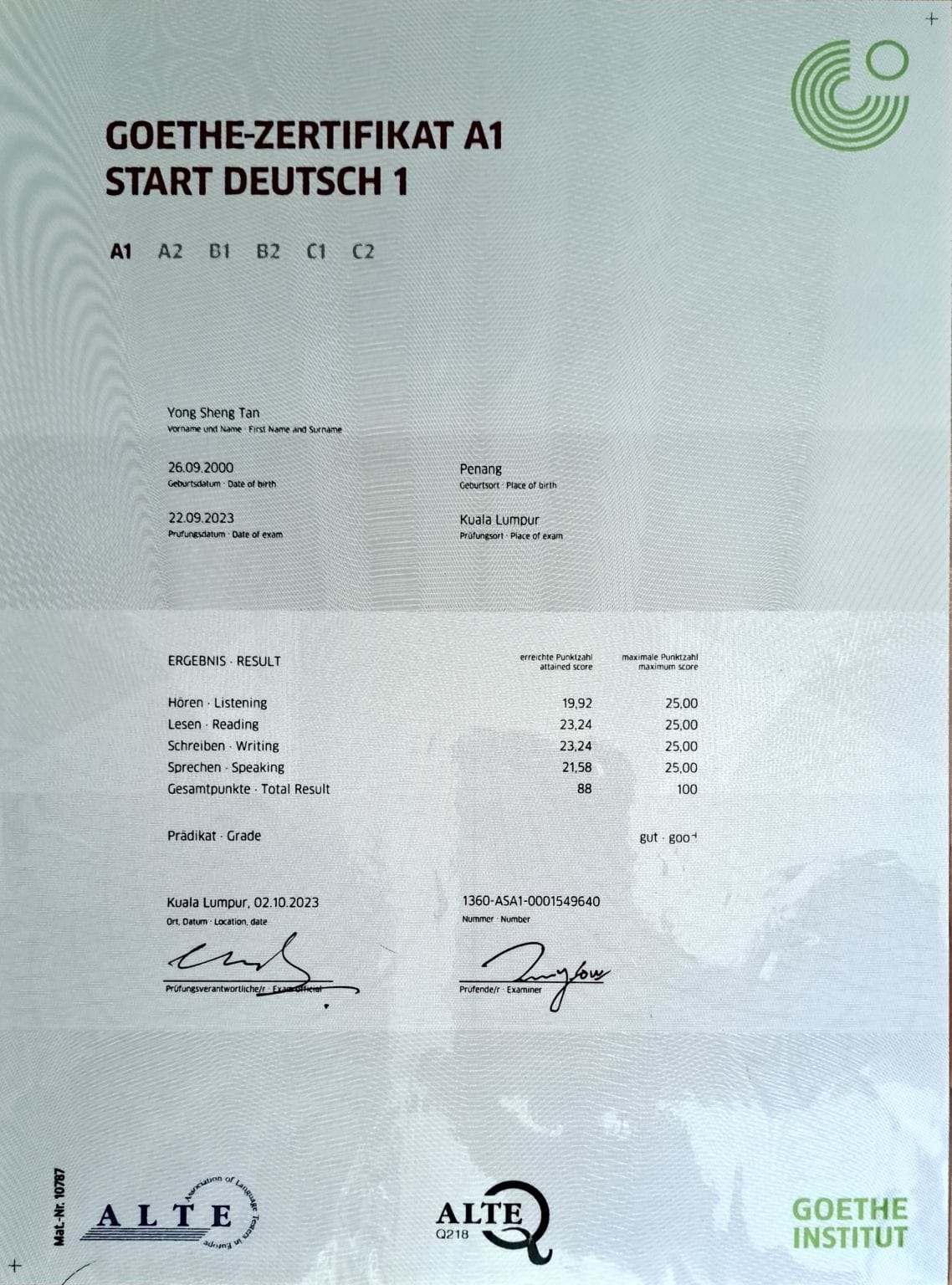
Geothe Zertifikat 4 All
Add a review FollowOverview
-
Founded Date June 14, 1990
-
Sectors Accountancy
-
Posted Jobs 0
-
Viewed 18
Company Description
15 Gifts For The A1 Certificate Buy Experiences Lover In Your Life
A1 Certificate Updates and Common Issues
 As the global workforce continues to expand and evolve and change, it becomes increasingly difficult to ensure the compliance with international employment laws. Recent updates to A1 forms, along with common issues emphasize the importance of knowing these forms.
As the global workforce continues to expand and evolve and change, it becomes increasingly difficult to ensure the compliance with international employment laws. Recent updates to A1 forms, along with common issues emphasize the importance of knowing these forms.
An A1 certificate is required if you plan to travel to work in several European countries. Are you aware of how to get an A1 certificate and when it is required?
1. Getting Started
The A1 Certificate streamlines cross-border work arrangements. It offers an efficient solution that is legally sound for both employees and employers. The certificate ensures workers are not liable to social insurance laws of more than one country which can lead to overpayments or administrative burdens. Anyone who is assigned to another EU member state is required to possess this certificate. It can be used by employees who travel to other countries for business, like attending meetings, conferences or fairs.
The steps to get an A1 certificate can differ slightly between countries however the fundamentals are the identical. Employees must first check their eligibility, then fill out the relevant form with the appropriate authority. This includes details of their home country, their employer and the destination countries they will be working in. In most cases, it is best to complete this form online. Then, employees must complete the form and submit the required documents to their home country’s social security authorities.
Once an A1 certificate has been issued, it is valid for a year and can be used in any European Union country. However, there are a few ways to simplify the process for those who travel frequently to multiple EU countries. If an employee or self employed person frequently engages in their work in more than three Member States and is able to apply for a permanent certification that will allow them to contribute to the system in their home country for up to a year.
Those who don’t secure an A1 certificate prior to embarking on a business trip could be penalized with fines. Inspectors in France, Austria, and Switzerland have recently announced a series of checks aimed at businesses that fail to provide their employees the necessary paperwork. Local authorities may deny access to a construction site in the event that, for instance, an employee is sent there without an A1 certification. Employers and hosting companies that fail to provide their employees with A1 certificates be fined. It is crucial to begin the A1 certification process as soon as is possible.
2. Documentation
The A1 certificate is an important document for Geothezertifikat4all.de those who travel to other countries frequently for work. The certificate proves that a person is insured in their home country, which can help them to avoid paying for social security in the country they’re traveling to. This could save businesses a lot of cash in the long term. However, it’s important for employers to be aware of what documents are needed for their employees to complete this form.
Employees who work abroad must carry an A1 certification to avoid penalties and fines. This is especially true for project workers, who may be asked to present the document when they register at hotels or attending conferences. It’s important to stay up-to-date with the latest A1 certification rules and regulations. Recent changes could impact the way this process works.
The main purpose of the A1 certificate is to stop social dumping, which occurs the case when a worker is posted in another European Union member state without being properly covered by their home country’s social security system. The A1 certificate is designed to guard against this by showing that a worker is insured in their home country. Employees, civil servants and self-employed workers need to obtain an A1 certification when they are posted to an EU member state or Iceland, Norway, Liechtenstein or Switzerland for work-related reasons.
A1 certificates are usually issued by the statutory health insurance provider for the person who is in need of. The form is basically an official letter that contains information such as the person’s name and address. The form also has a special section that lists the country to which the person plans to travel for work and a description of what they will be doing.
For instance for employees who are traveling to the UK for work, they must provide details of their regular schedule and income-generating activities within the country. Maintaining detailed time and location records can help ensure that the employee is eligible for an A1 certificate in the event that local authorities have any questions.
3. Payment
A1 Certificates are proof that employees contribute to the social security system of their home country while temporarily working in another European country. This helps prevent social and wage dumping when short-term cross border work assignments are made. Employers can avoid double contributions if they have multiple placements in different countries.
In general, it’s recommended to start the process of acquiring an A1 form when it becomes clear that an employee is required to work abroad. Depending on the country it is possible to get an A1 form as early as two weeks after an employee begins their overseas assignment.
The A1 form requires a large amount of detail about the employee’s employment status as well as their current job. It must also include the dates when an employee will be on assignment abroad. The information must be correct or you could face a fine.
Many companies utilize A1 Certificates to allow employees to travel throughout Europe. This is particularly true for businesses that operate in areas where several languages are spoken. This type of certification ensures that employees will be in a position to communicate with their customers in the language of the country where they work.
A1 forms are also crucial for freelancers and contractors who work on short-term projects in other EEA countries. Imagine, for example, that a graphic designer in Manchester signs a six-month agreement with a company located in Italy. By obtaining an A1 certificate, she will be able to continue to pay her UK National Insurance contributions and will not be required to make additional payments in Italy.
It is also important to remember that it is possible for an employee to lose their A1 certificate if they fail to maintain its validity while in another country. It is important to renew an A1 form at the time it expires.
The process of obtaining an A1 form is a long-winded procedure that is based on the legal nuances of multiple international laws and the specific requirements of both an employee’s home country and the host country. GoGlobal streamlines the procedure by guiding clients through every step and ensuring all documents are in compliance with regulatory standards.
4. Delivery
The A1 certificate is essential to ensure that employees who travel to work in EU countries are given the right treatment. This includes non-EEA countries which have a treaty with the EU for example, Norway and Switzerland. These regulations remain in effect despite the UK’s withdrawal from the EU. With significant changes to the process alongside the usual issues faced by applicants, it is vital for employers who send their employees abroad to have a robust understanding of the A1 requirements.
CIBT Assure streamlines A1 and reduces the risk of compliance for clients. CIBT Assure provides expert guidance throughout the entire process, making sure that every employee submits their application with no errors. CIBT Assure’s automated, secure electronic tracking and application system reduces the time needed to complete each submission. It also allows HR departments to seamlessly integrate the system with existing HR and payroll systems to provide automated data pre-population as well as real-time status updates.
In addition to easing the process, CIBT Assure provides a set of tools and resources that help employees navigate the A1 process. From a dedicated support team to a mobile application that is free and comprehensive guidebook, employees can stay on top of the process and receive timely status reminders and updates. A central portal also offers an overview of the status of every A1 submission.
The CIBT Assure guidebook is designed to provide employees with practical advice and best practices. It also outlines the different types of A1 applications and the times when each type is required. It assists employees to understand their status as independent workers or multi-state employees and also identify any gaps in the information they’ve provided to HMRC.
The A1 process is a complicated and time-consuming one, particularly for employees who navigate the process on their own. It is essential that employees work with an established partner to handle the A1 process. This will lower their chance of making a mistake and ensure they continue to receive benefits from the social security organization in their home country even if they are they are in the EU. The no-risk A1 Certificate cheat sheet from CIBT Assure is a great resource for processing tips, common issues and practical solutions.
